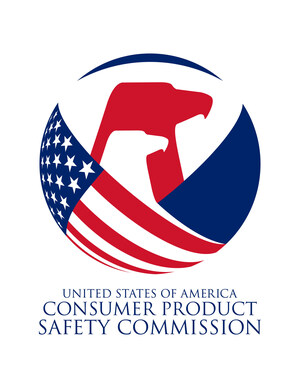WASHINGTON, July 11, 2023 /PRNewswire/ -- The U.S. Consumer Product Safety Commission (CPSC) is warning victims of the flooding in New England and New York to take steps to protect themselves and their families against carbon monoxide (CO) poisoning, electrocution, explosion and fires.
If Your Home Floods—Dangers with Wet Appliances
- Look for signs that your appliances have gotten wet. Do not touch wet appliances that are still plugged into an electrical source.
- Before using your appliances, have a professional or your gas or electric company evaluate your home and replace all gas control valves, electrical wiring, circuit breakers, and fuses that have been under water.
Loss of Power—Using a Generator Safely
Consumers need to be especially careful when storms knock out electrical power. CO poisoning from gasoline-powered portable generators can kill in minutes. CO is called the invisible killer because it is colorless and odorless. CO poisoning from portable generators can happen so quickly that exposed persons may become unconscious before recognizing the symptoms of nausea, dizziness or weakness.
An average of nearly 100 consumers die in the U.S. each year from CO poisoning from portable generators, according to CPSC's latest report on Non-Fire Carbon Monoxide Deaths Associated with the Use of Consumer Products.
In the case of a power outage, follow these important life-saving tips:
- NEVER operate a portable generator inside a home, garage, basement, crawlspace or shed. Opening doors or windows will not provide enough ventilation to prevent the buildup of lethal levels of CO.
- Operate portable generators outside only, at least 20 feet away from the house, and direct the generator's exhaust away from the home and any other buildings that someone could enter, while keeping windows and other openings closed in the path of the generator's exhaust. Do not operate a generator on an outside porch or in a carport. They are too close to the home.
- Follow portable generator instructions about electrical shock hazards in inclement weather, which may include use of an NFPA-rated non-combustible generator tent or may state to wait to use the generator until rain passes.
- Check that portable generators have been maintained properly, and read and follow the labels, instructions, and warnings on the generator and in the owner's manual.
- Look for portable generators that have a CO shut-off safety feature, which is designed to shut the generator off automatically when high levels of CO are present around the generator. These models may be advertised as certified to the latest safety standards for portable generators–PGMA G300-2018 and UL 2201–which are estimated to reduce deaths from CO poisoning by 87% and 100%, respectively. UL 2201 certified models have reduced CO emissions in addition to the CO shut-off feature.
Check CO and Smoke Alarms
- Working smoke and CO alarms save lives! Install battery-operated CO alarms or CO alarms with battery backup on each level and outside separate sleeping areas at home. Interconnected CO alarms are best; when one sounds, they all sound.
- Make sure smoke alarms are installed on every level and inside each bedroom at home.
- Test CO and smoke alarms monthly to make sure they are working properly, and replace batteries, if needed. Never ignore an alarm when it sounds. Get outside immediately. Then call 911.
Dangers with Charcoal and Candles
- Never use charcoal indoors. Burning charcoal in an enclosed space can produce lethal levels of carbon monoxide. Do not cook on a charcoal grill in a garage, even with the garage door open.
- Use caution when burning candles. Use flashlights or battery-operated candles instead. If using candles, do not burn them on or near anything that can catch fire. Never leave burning candles unattended. Extinguish candles when leaving the room and before sleeping.
Dangers with Gas Leaks:
- If you smell or hear gas leaking, leave your home immediately and contact local gas authorities from outside the home. Do not operate any electronics, such as lights or phone, before leaving.
CPSC resources:
Poster – Carbon Monoxide (CO) the Invisible Killer
Poster – Carbon Monoxide (CO) the Invisible Killer (Spanish)
Carbon Monoxide Safety Center
Carbon Monoxide Safety Center (Spanish)
Fire Safety Center
Fire Safety Center (Spanish)
Link to broadcast quality video for media:
Flood safety b-roll: https://spaces.hightail.com/space/thCBWTX157
CPSC spokespeople are available for interviews. Email [email protected] or call 240-204-4410 to arrange for an interview.
Individual Commissioners may have statements related to this topic. Please visit www.cpsc.gov/commissioners to search for statements related to this or other topics.
About the U.S. CPSC
The U.S. Consumer Product Safety Commission (CPSC) is charged with protecting the public from unreasonable risk of injury or death associated with the use of thousands of types of consumer products. Deaths, injuries, and property damage from consumer product-related incidents cost the nation more than $1 trillion annually. CPSC's work to ensure the safety of consumer products has contributed to a decline in the rate of injuries associated with consumer products over the past 50 years.
Federal law prohibits any person from selling products subject to a Commission ordered recall or a voluntary recall undertaken in consultation with the CPSC.
For lifesaving information:
- Visit CPSC.gov.
- Sign up to receive our e-mail alerts.
- Follow us on Facebook, Instagram @USCPSC and Twitter @USCPSC.
- Report a dangerous product or a product-related injury on www.SaferProducts.gov.
- Call CPSC's Hotline at 800-638-2772 (TTY 301-595-7054).
- Contact a media specialist.
SOURCE U.S. Consumer Product Safety Commission

WANT YOUR COMPANY'S NEWS FEATURED ON PRNEWSWIRE.COM?
Newsrooms &
Influencers
Digital Media
Outlets
Journalists
Opted In




Share this article